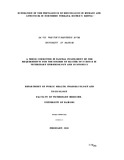| dc.description.abstract | Brucellosis is an important zoonosis especially among the pastoralists like the Turkana
who live in close contact with their livestock. A cross-sectional study was performed to
determine the sera-prevalence of brucellosis in cattle, goats and humans in the northern
part of Turkana District, Kenya and also to identify risk factors for the infection. Serum
samples were collected over a period of four months starting October, 2006 to February,
2007. The study area was stratified into three regions reflecting how the area is served by
the three major livestock routes. The samples were then collected from the different
livestock camps using systematic sampling. The total samples collected were as follows:
200 from cattle, 400 from goats and 174 from humans. All the serum samples were
screened using the Rose Bengal Plate Test (RBPT) and thereafter subjected again to
Competitive ELISA (cELISA) Test. In addition, using questionnaires, information
regarding risk factors for brucellosis in both livestock and human was collected. The risk
factors assessed with regard to brucellosis in livestock were: management (grazing and
watering) system, introduction of new stock, level of awareness regarding brucellosis and
frequency of contact with extension staff. Risk factors assessed with regard to the
infection in humans were:- close association with livestock, consumption of raw livestock
praducts such as milk and blood and level of awareness about brucellosis.
In this study, an overall seroprevalence of 17% was observed in humans, 13% in goats
and 11% in cattle based on Competitive ELISA test. The Rose Bengal Plate test gave the
seroprevalence of 1.7% in humans, 2% in goats and 3.5% in cattle.
The level of agreement for the two tests using the kappa statistic was determined and it
showed that there was a moderate agreement in cattle (Kappa = 0.45), and slight
agreement in goats (Kappa = 0.24) and humans (Kappa = 0.16)
Using Univariate logistic regression analysis, the major risk factor for seroposiiivity in
livestock was identified as communal grazing of the animals (P<O.OO1 for cattle and
P=0.003 for caprines). In humans, brucellosis was high among the pastoralist group
compared to the non-pastoralist population (P=0.007). Consumption of raw blood was
also significant (P=0.025). The level of significance was worked out at 95% confidence
interval.
The study reveals that brucellosis is widely distributed in northern Turkana in cattle,
goats and humans and therefore constitutes an important economic and public· health
challenge. The study results provide baseline data for future studies of brucellosis
infection in Turkana District and a starting point for initiating control measures in both
livestock and humans. | en |

